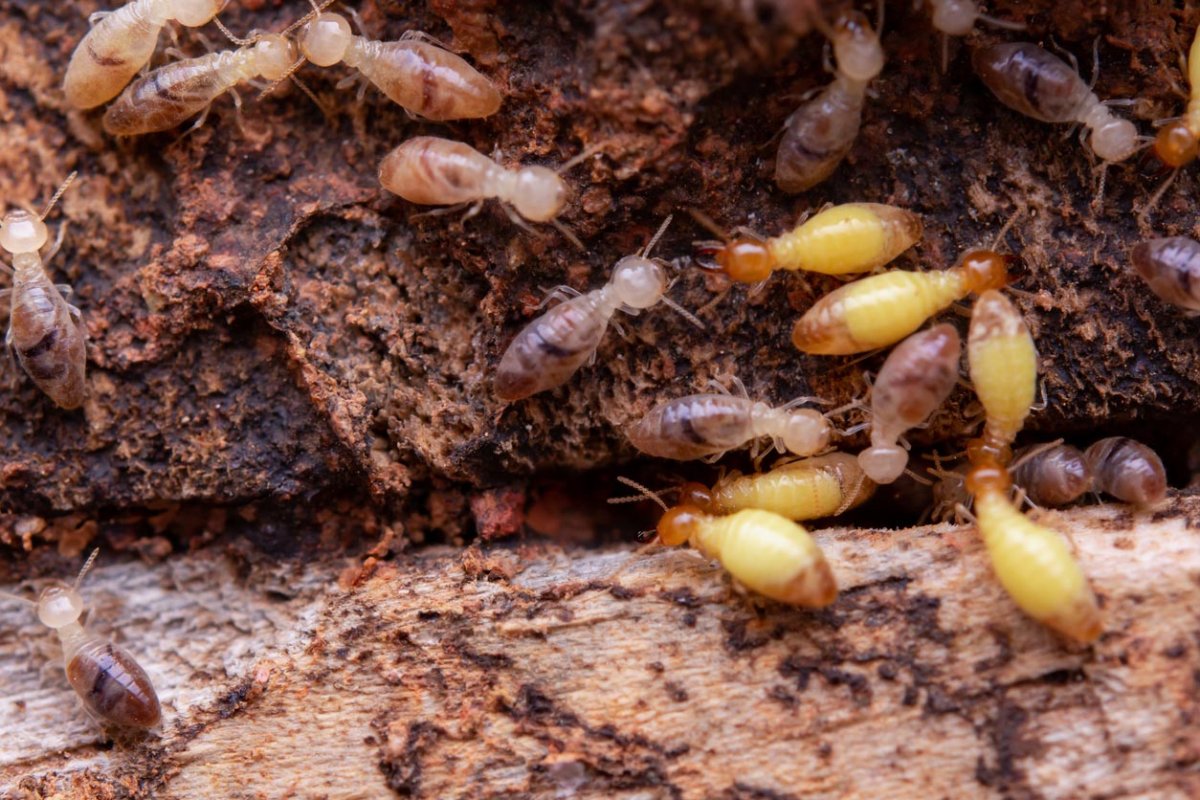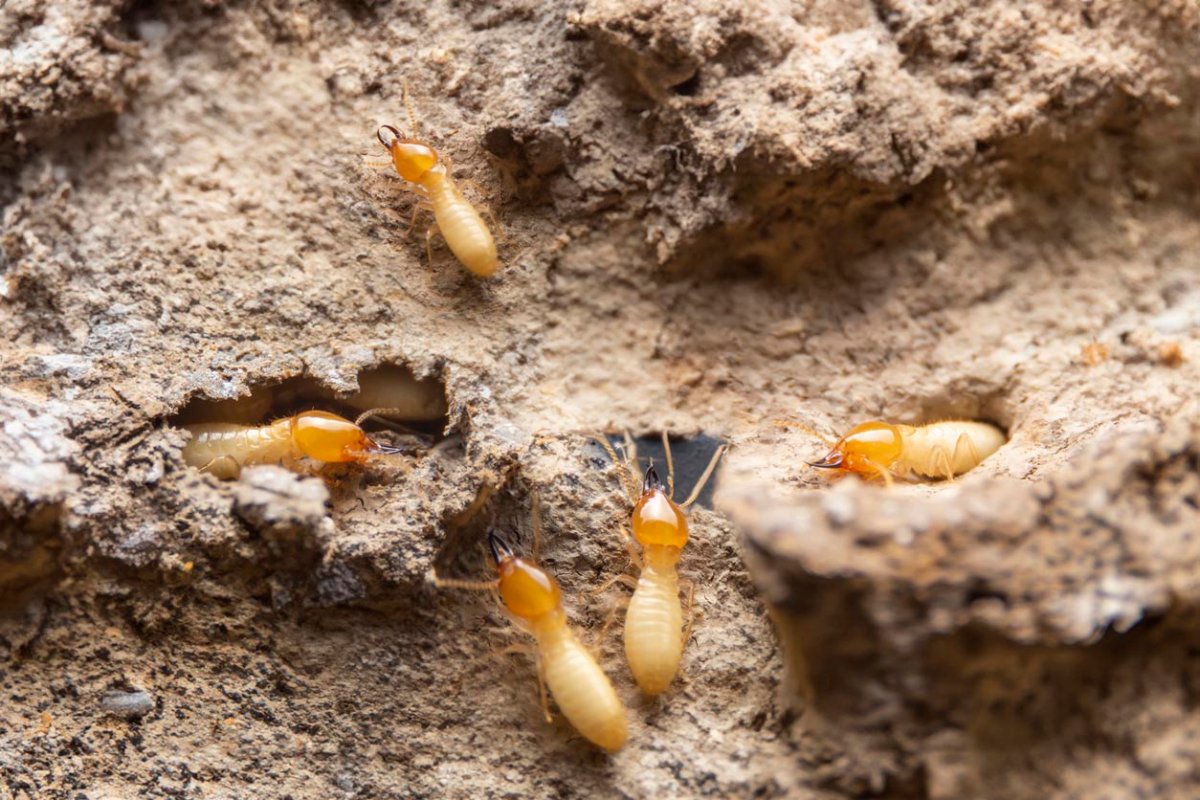We may earn revenue from the products available on this page and participate in affiliate programs. Learn More ›
From stink bugs to ants and even ladybugs, there’s no shortage of pests that can terrorize and take over your home. Thankfully, some of the best pest control companies or DIY methods can help eradicate unwelcome visitors and infestations.
Termites, however, are in a class of their own. When left unchecked, they are some of the most destructive pests that can infest a home. They can cause lasting structural damage to a house, making it uninhabitable and costing the homeowners thousands of dollars in repairs. In fact, termite damage repair cost can go up to $3,000—or even more. Signs of termites can be subtle: clicking noises behind the walls, windows that are hard to open, and hollow-sounding wood around the home can potentially go unnoticed until it’s too late and the home needs extensive repairs.
Getting rid of termites is no easy feat, either. While there are some DIY methods that can work for small colonies, it’s hard for the average homeowner to know the true extent of an infestation, and not fully addressing the problem only delays inevitable issues.
To determine the popularity of termite control, we reviewed how our readers have engaged with our content covering this project from March 2022 to March 2024. We defined “popularity” by focusing on topics with a higher-than-average number of readers, clicks to our vetted and recommended professionals, and even direct bookings made through our links. We also considered external official reports and studies. We used National Geographic’s definition of U.S. regions in this study.
Key Takeaways
- Termites are some of the most destructive pests, causing billions of dollars in damage every year.
- There is mounting evidence that termites are expanding their territory to include areas and regions that were previously inhospitable.
- Climate change is a primary driving force behind this phenomenon. According to BobVila.com data, readers in the Midwest made 300 perent more inquiries about pest control services for a termite problem. We predict the Midwest to be the next termite hotspot.
- Termites can be difficult to eradicate. Often, a qualified pest control expert is needed to fully address the problem. Taking preventative measures is also recommended.

Termite Season in the United States
In the United States, there are around 45 species of termites, and each falls into one of three categories: subterranean, drywood, or dampwood termites. According to Orkin, subterranean termites are responsible for the majority of damage to structures.
Termites thrive in hot and humid environments. In the United States, that means they are the most prevalent in the South—states like Florida, Texas, Alabama, and Georgia. Southern California is also no stranger to termite swarms. In a 2024 report, Orkin named Miami, Florida; Los Angeles, California; and Tampa, Florida, as the top three most termite-infested cities based on its data.
Termites live in colonies, and when they are ready to mate and form new colonies in the spring and summer months, they swarm. Swarming happens when the insects leave the colony and seek new areas to nest—and this is how termites travel and invade homes. Swarming season also prompts them to seek open air and take flight, making it the time when most people will see termites outside their burrows and tunnels.
Termites on the Move
The 2024 termite season, which began in late February into March in some places, is showing signs of a shift from previous years.
Already in the first weeks of the season, there was some concerning news around termites. Pest Control Technology reported on the first recording of Asian subterranean termites in California, and Insurance Journal declared that subterranean termites have created a “new normal” in Florida due to how widespread their damage has become.
These news reports are highlighting a worrying phenomenon: Termites are on the move or becoming more destructive in areas where they already exist. Orkin’s 2024 report shows this in the way different cities moved up and down its list. New York, for example, reached the number four spot on the list, rising five places from the year prior. Philadelphia jumped a whopping 10 spots, coming in sixth place on the list.
What’s perhaps more telling is which cities were new to the list: Louisville, Kentucky; Oklahoma City, Oklahoma; Roanoke, Virginia; and Waco, Texas. These cities are located in “moderate to heavy” risk areas for termites, according to termite infestation probability zone (TIP zone) maps. TIP zones were created by the U.S. Department of Housing and Urban Development to determine property requirements and regulations for homes in areas at risk of being impacted by termites. Seeing these cities new to the list begs the question: Are these areas actually more at risk for termite infestations than they were even just a year ago? Do these areas now have a “very heavy” risk of termite infestation, instead of a “moderate to heavy” risk?
BobVila.com readers have had their own battles with termites. Inquiries for pest control specifically for termites rose 16.3 percent in 2023 (compared with the demand in 2022). Who requested termite control also shifted ever so slightly. Readers in the Northeast sought to hire pros for pest control at a similar rate as for 2022, but more inquiries were made earlier in the 2023 termite season. Readers in the Midwest experienced more termite issues in 2023 than they did in 2022, with inquiries for termite control more than tripling.
| Region | Year-Over-Year Change |
| Northeast | 0% |
| Southeast | -10.5% |
| Midwest | 300% |
| Southwest | -25% |
| West | 63.6% |
Climate Change: An Advantage for Termites
Why is the termite problem getting worse in some places, ebbing in others, and cropping up more recently in some areas?
Part of the answer is simple: travel. Travel is suspected to have brought about the arrival of the Asian subterranean termites in California. The boat the species was found on had allegedly traveled in international waters around Central and South America—and the termites hitched a ride back to California. Pest Control Technology interviewed Dr. Chow-Yang Lee of UC Riverside for its above-referenced article, who is cited as stating that while it’s unlikely that this particular species of termite will be prevalent in California, it does risk eventually establishing colonies in Southern California around the coastal areas. While there’s no telling what will happen, it wouldn’t be the first time a non-native species of pest was introduced to the United States via travel.
Another part of the answer is a little more complex. Climate change is affecting everything from average temperatures to rainfall amounts to humidity levels. It’s also causing many animals to expand their territories (the armadillo is an example of this phenomenon). Termites are no exception. Because they thrive in hot and humid weather and global warming is, by definition, the warming of the planet, termites are finding—and will continue to find—new environments. Places that were previously too cold for termites are becoming tolerable. Regions that saw termite activity during the summer months are likely to start seeing that activity start earlier in the year.
But that’s not the only way termites thrive with climate change. According to a study published in Science, termites actually eat deadwood faster in warmer temperatures. And Phys.org claims that termite territories could expand by as much as 30 percent of their current range. As their current environment warms, termites are causing more damage more quickly, and their population size is growing as a result.
Climate change does risk reducing their activity in some areas. BobVila.com readers in states located in the Southwest and in the Southeast experienced average or lower-than-average termite swarming. Broadly speaking, there appeared to be a slight decrease in activity in places where termite activity is typically high. Even termite exterminators in those areas were disappointed by the 2023 season, according to the 2024 State of the Termite Control Market Report. They cited drought in some states and areas, such as Mississippi, as the culprit behind lower demand for termite control services.
While climate change seems to be fueling termite activity and swarming, termites are actually contributing to climate change, too. According to an article in PNAS (Proceedings of the National Academy of Sciences), termites actually produce 1 to 3 percent of global methane (CH4) emissions. Termites might be small, but collectively they have—and will continue to have—an impact on our environment.

Tiny Travelers, Big Trouble
So where are these termite swarms heading? While it’s hard to tell exactly where they’ll establish roots, it’s safe to assume that any region that is experiencing warmer weather earlier in the spring months is at risk. The areas TIP zone maps identify as at “heavy to moderate risk” for termites might be considered to be “heavy risk” areas in the near future. Based on BobVila.com data, the Midwest might be the next termite hot zone.
Wherever termites end up, they’ll wreak havoc on homes. Their activity has a domino effect on homeowners even when they’re not infesting a home. One consequence of high termite activity in Florida, for example, has been the threat to the urban canopy (via the Sun Sentinel). Unchecked, termites can destroy hundreds of trees in very little time. When the insects feast on the trees, the trees become weak, making them a hazard in the event of a hurricane.
Researchers and scientists are trying to combat the termite issue. The University of Florida Institute of Food and Agricultural Sciences (UF/IFAS) even released an interactive map that homeowners and home buyers can use to assess their risk of a termite infestation. The map shows where specimens have been collected at some point in time.
According to the National Pest Management Association, termites cause (both directly and indirectly) billions of dollars in damage to homes every year, making them tiny harbingers of real estate misfortune.
Terminating Termites
Homeowners dealing with an existing termite problem or who suspect termites in the home may want to play it safe and pay the cost of a termite inspection—it’s well worth it if it means protecting a valuable investment. Ultimately, choosing the DIY route may be risky. It’s best, in most cases, to find one of the best termite control companies to take care of the problem. Terminix, for example, is a reputable and top-recommended company that specializes in termite infestations, and it has branches all over the United States.
There are several key steps to finding the right termite control company. Ultimately, homeowners will want to be sure that the business they hire is confident in its ability to eradicate the problem and can offer guarantees on its work. Investing in preventive measures can also go a long way. Finding ways to divert moisture from the home, keeping firewood stored away from the home, and hiring a pest control company that uses products to protect the home’s structure can help keep a home safe from tiny yet destructive pests.


